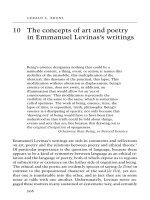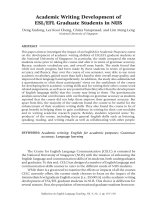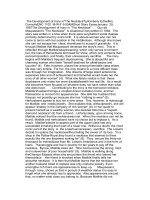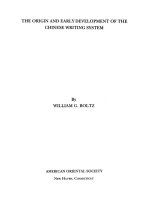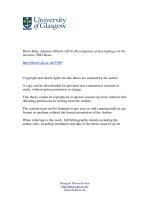development of art throughout history
Bạn đang xem bản rút gọn của tài liệu. Xem và tải ngay bản đầy đủ của tài liệu tại đây (42.82 KB, 3 trang )
The evolution of sculpture in ancient Greece is one of the most forthright examples of how art
changes with the times and thoughts of the people. People, the Greeks in particular, were putting
themselves in high standing as the epitome of form and relative celestial importance. There was an
obvious transition of their work from the Archaic to the Classical Period. It became more refined
as time passed and this showed me an example of how slow change produces dramatic effects.
Three figures, created over an approximate period of 150 years, show the progress. From the 580
B.C.E. Kouros to the 525 B.C.E. Kuros from Anavysos to the Doryphorus of 450-440 B.C.E.
With the increasing concern for the self in Greek culture we see a shift happening that is recorded
in the attention and development of their art. Amazing changes began to take place and the
sculptures serve as markers for an awakening of the human consciousness as we can see in later
pieces. The naturalism of the sculptures seem to increase dramatically from the first, where the
shoulders are wider than the hips and little detail is given to the chest and arms to the second,
where the chest and stomach are better defined and the hips are better proportioned to the
shoulders. More detail is given to muscle tone and shape in the second sculpture. The final piece
is the culmination of decades and even centuries, of advancing realization in Greek art. We see the
style moving into its most refined stages with hints of more beautiful and awe-inspiring works just
over the horizon. One arm is relaxed while the opposite leg is also. The other leg and arm are
tense. The head and hands are in perfect proportion and the figure looks as if it would move at any
time.
High Renaissance refers to the climax of Renaissance art from c. 1500-1525. This was the period
when painting especially reached its peak of technical mastery. Italian art attained the High
Renaissance ideal of harmony and balance within the framework of classical realism, most notably
in the work of artists Leonardo DaVinci (1452-1519), Michelangelo Buonarroti (1475-1564), and
Raphael (Raffaello Sanzio) (1483-1520), along with the great Venetian masters, Titian (c.
1485/90-1576) and Tintoretto (1518-1594). But the finest sculptor of this time would certainly
have been Donatello (1386-1466). It seemed that (with his statue of Saint Mark), for the first time
since classical antiquity and in striking contrast to medieval art, the human body is rendered as a
self-activating, functional organism, and the human personality is shown with a confidence in its
own worth.
While many regional expressions of form developed throughout Europe, Romanesque often refers
to all works of this era, including the later Norman variations. The most recognizable feature of
these buildings is there massiveness. In a general sense, it is easy to distinguish such structures
from their more slender descendants in the Gothic era. The Church of San Vitale is made of sliver
and gold. The subject matter is two figures of Christ from his younger years and the other is from
his martyrdom. Figures of apostles, animals, and birds are woven into a network of vines,
branches, leaves, and grapes. The Church of San Vitale is found in Ravenna with a brick facing. It
is a centrally planned church with a ground level, gallery, and clerestory. The inside shows Old
Testament and New Testament scenes, symbols, patterns, and imperial portraits. Those are
beautiful gold mosaics. The Apse Mosaic is found in San Vitale. This building is widely espoused
as the "prototype Gothic building", but the cathedral is in fact a mix of different styles and is also
extremely conservative in its structure. Built in a relatively short period of time, it is hailed as a
"beautifully unified" building. In reality, there are numerous subtle adjustment and variations in
the details. Gothic sculpture was calmer, grander, and more humane. Most of the early Gothic
sculpture was created to decorate cathedral entrances. Some of the finest examples decorate the
west facade of Chartres Cathedral. They probably portray Bible figures from the Old Testament.
While many religions have made use of figural images to convey their core convictions, Islam has
instead used the shapes and sizes of words or letters. Because Islamic leaders saw in figural arts a
possible implication of idolatry, Islam's early theocracy looked to the artistry of calligraphy for
religious expression. In Islamic and Arabic cultures, calligraphy became highly respected as an art
the art of writing. The primacy of the word in Islam is reflected in the virtually universal
application of calligraphy. Writing is given pride of place on all kinds of objects objects of
everyday use as well as entire wall surfaces, mosque furniture, the interiors and exteriors of
mosques, tombs, and al-Ka'ba, the most famous sanctuary of Islam. But like the icons of most
other faiths, script also represents power. Arabic calligraphy is a primary form of art for Islamic
visual expression and creativity. Throughout the vast geography of the Islamic world, Arabic
calligraphy is a symbol representing unity, beauty, and power. The aesthetic principles of Arabic
calligraphy are a reflection of the cultural values of the Muslim world. A thorough investigation
into the aesthetic differences between Arabic and non-Arabic calligraphy might provide an
approach for understanding the essential spirit of each culture.
From its inception in ancient India to the present, Buddhism has inspired some of the world's most
astounding artistic creations. The tiny island nation of Sri Lanka off the southeast coast of India
has a rich heritage of Buddhism and Buddhist art. Sri Lanka's role in the dissemination of
Buddhism into Southeast Asia and beyond is undisputedly a major one. Scholars generally agree
that after its decline in India after the 6th century, Buddhism remained a vital force in Sri Lanka,
spreading its religious roots and artistic influences across the rest of Southeast Asia. The most
elaborate and well known of the more than 50 magnificent Buddhist monuments that crown the
hilltop of Sanchi, India, is Stupa Number One or the Great Stupa. It is part of an entire complex of
structures, mostly stupas, built between the 3rd Century BCE and the 12th Century AD. The stupa
is not a building in any traditional sense. Once a burial or reliquary mound, the stupa has become
a purely symbolic object.
With the fall of the Tang Dynasty, the golden age of China was in decline. Once again, China was
divided into five states. The Five Dynasties (906-960) produced undistinguished artists. However,
the period of unrest laid foundation for the The Song Dynasty (960-1279 A.D.), which reunited
China in 906 A.D. The new Song empire was smaller that its predecessor, the Tang. China's north
eastern was still controlled by the Liao, which would succumbed to the Jin conquerers in 1126, the
event forced the Song to vacate its northern capital to the more hospitable south. Thus began the
era of the Southern Song rule. In contrast to the Tang, the Song rulers were introspective; they
seek inspiration from traditional values and shied away from anything foreign. As a result, there
was a renewed interest in Confucianism, Daoism and Buddhism.
Neoclassicists, whose tradition traced back to Greek art and architecture, considered their goal to
be the perfection of humanity, and the consequential subduing of nature. The paintings of the
Neoclassicists bear the mark of careful study in perspective and form, and reflect a world-view
that is well ordered and anthropocentric (human-centered). In landscape, man and the creations of
man enjoy the most conspicuous placement, especially those of Greco-Roman architecture or
design. In portraiture, its subjects wear the most formal dress and neutral expressions, not seeking
to provoke emotion but to present a clear, rational picture of a person or event. One example of a
Neoclassicist painter is Jacques-Louis David. Naturalism enjoyed renewed popularity in the
poems and literature of the Romantics, which expressed a reverence for nature and an appreciation
of her many gifts. Its poets were Wordsworth, Coleridge, Lord Byron, Keats, Shelley, and
Spencer, and among its philosophers were Rousseau, Hegel and Schopenhauer, they greatly
influenced by the writing of Immanuel Kant. The contributions that Romanticism offered to the
practice of portraiture were manifold. Of these, two of its more extraordinary themes are notable:
the complex of the Romantic Hero, a concept that embraced the bold individual who achieved
greatness and challenged the values of his time. One example of a romanticist painter is
Antoine-Jean Gros.
In Japan, there has been existed the traditional Japanese arts for a long time. They have formed
characteristic culture under the influences from China. But it is not clear whether we can call them
"Art" or not. If you want to call everything including grotto painting, masks or decoration of daily
necessities by the name of "Art", Japanese traditional architecture, crafts, painting, statues and
poem would be of course Art as the Human inheritance. However, the idea of Art as the universal
and perpetual domain of culture is just a fiction invented in European modernity. In Japan, this
cultural project that registers the various esthetic fields into "Art", holds exhibitions, gives awards
of painting or literature, introduces Art into the curriculum of university or collects works of Art
in museums, began after the Meiji Restoration only 126 years ago. In addition to this, it was after
World War II that the museums in the Western meaning not only for collection of historical
inheritance but also for raising new cultural movements were born in Japan. In the development of
Japanese modern Art, if limited in painting, there are mainly three domains, which have been
progressing separately. The first domain is called Nihon-Ga, which means basically traditional
Japanese painting but added with some modern sensibilities in it. That has purely Eastern style
both in its materials and methods. But it would better be understood as a simulation of the
traditional Japanese paintings. Another is called Yo-Ga, Western painting, however it has very
limited simulation of certain styles of European painting, for example, Impressionism, Fauvism,
Ecole de Paris or Expressionism before World War II. These two streams were institutionally
established and guaranteed before War and they have very powerful influence even now in the
system of Japanese Art. The third is Gendai-Bijutsu Contemporary Art which is much more
minor both in power and in popularity than them. This is the only group, which opens itself toward
foreign countries, but they have no institutional foundation and must rely upon evaluation from
abroad.
